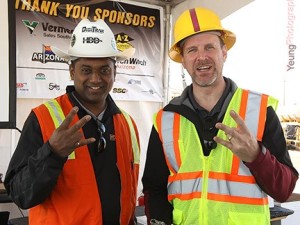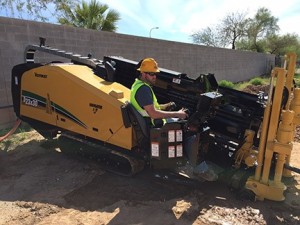While you were at work today, it’s possible that a new telecommunications conduit system
 was installed along the entire length of your neighborhood without leaving a trace — except possibly for a few paint marks above existing underground utilities and small pothole repairs needed in the street or sidewalk. “No streets were demolished, your driveway remained intact and the trees in your neighborhood playground were left unscathed,” explains Samuel Ariaratnam, Ph.D., P.E. from ASU’s School of Sustainable Engineering and the Built Environment (SSEBE), one of the Ira A. Fulton Schools of Engineering.
was installed along the entire length of your neighborhood without leaving a trace — except possibly for a few paint marks above existing underground utilities and small pothole repairs needed in the street or sidewalk. “No streets were demolished, your driveway remained intact and the trees in your neighborhood playground were left unscathed,” explains Samuel Ariaratnam, Ph.D., P.E. from ASU’s School of Sustainable Engineering and the Built Environment (SSEBE), one of the Ira A. Fulton Schools of Engineering.
According to Ariaratnam, pipes carrying utilities like telecommunications, electrical, water, gas and fuel are now installed using horizontal directional drilling (HDD), also known as trenchless or no-dig drilling, with nominal disruption to highways, streets, sidewalks, railways, riverbeds and ecologically sensitive areas.
“Instead of digging a trench, HDD contractors bore holes beneath the surface and pull those pipes through — not only leaving the landscape virtually unmarred, but also saving the costs of restoration,” Ariaratnam says.
Although HDD technology has been around for about 40 years, “we’re in the middle of a resurgence of the fiber optics revolution,” says Ariaratnam. “In the next year or so, especially as new telecommunications technologies like Google Fiber come to the valley, it is possible we’ll see 80 to 100 HDD rigs in the Phoenix area.”
Maricopa Association of Governments updates utility installation specs
To keep up with evolving technology, the Maricopa Association of Governments (MAG), a regional planning and policy agency for the Phoenix area, has updated its specifications for installing underground utilities to include HDD. Arvid Veidmark, who represents the Arizona Utility Contractors Association (AZUCA) on the MAG Specifications and Details Committee, was instrumental in bringing industry expertise to the development of the new specification that is now Section 608 in the MAG Uniform Standard Specifications and Details for Public Works Construction.
“Without a standard specification, cities such as Tempe, Avondale and Phoenix would have to create their own supplements,” explains Veidmark. “And there was nothing to ensure that the Phoenix version was close to the Avondale version.” The MAG committee provides the method of coordination between the cities to ensure standardized construction throughout the region.
Veidmark, an owner of Specialized Services Company (SCC), an underground utility installation construction company, has worked with Ariaratnam for more than 15 years on a variety of projects both locally and as far away as Toronto and Dubai. He says asking Ariaratnam and Aaron Cohen, who was an HDD contractor before his return to his alma mater ASU as a lecturer, to join the team was an obvious choice.
Many of the HDD specs were added in a “cut and paste” mode. “You shouldn’t be using same specs for a 42” natural gas transmission line that you use for a cable or telephone line installation,” Cohen says. “Until now, nobody had worked out the details for the different types of projects. Contractors were bidding on projects without understanding best methods, and cities weren’t adequately prepared to evaluate proposals.”
Also important is ensuring that contractors and subcontractors are qualified to do an installation; the new spec requires that key personnel have certificates of training as appropriate. Ariaratnam and Cohen are both instructors for the North American Society for Trenchless Technology (NASTT), and in addition to working with contractors, have developed training programs for agency personnel. “It’s critical that a municipality’s inspectors are familiar with the latest equipment and procedures,” says Ariaratnam.
Collaborative effort
Jim Badowich, City of Avondale Construction Manager, chairs both MAG’s Water and Sewer
 Working Group and the Specifications and Detail Committee. “MAG members, including various agencies and contractor representatives, have been discussing a new HDD specification for some time now,” explains Badowich, “So we are all excited to see it become a reality.”
Working Group and the Specifications and Detail Committee. “MAG members, including various agencies and contractor representatives, have been discussing a new HDD specification for some time now,” explains Badowich, “So we are all excited to see it become a reality.”
While MAG typically tries to work with the contracting and manufacturing communities to get current industry information as specs are updated or added, this case was somewhat unique in that public utility companies were actively involved in the entire process, both in providing input and ultimately, reaching consensus on the final spec.
According to Badowich, telecommunication companies have been using HDD to install conduits for years as a cheaper and lower impact means of construction, making a cohesive HDD spec increasingly necessary as cities typically permit and inspect these installations within their rights-of-way. “Plus, more and more cities are now using HDD for their own projects that require the installation of underground conduit systems, such as intelligent transportation systems (ITS) and traffic signals,” he says.
The most important component of Section 608 of the MAG specifications addresses the requirements for three HDD bore sizes — small, medium and large — based on calculating the length of the installation by the diameter of the pipe, or inch-feet. For example, a 200-foot installation of a 4-inch pipe would be a bore size of 800 in-ft. According to Cohen, the average installation is roughly 400 to 500 feet long, with the longest on record in the vicinity of 11,000 feet.
In addition to bore size classifications, the spec establishes preliminary document requirements (site surveys, personnel qualifications, etc.), and clarifies
other requirements based on the type of project.
Room for innovation
Gordon Tyus, the MAG representative coordinating the committee’s efforts, points out that while the spec is likely the most comprehensive on HDD in the region, MAG didn’t want to detail too much of the process. “We wanted to make sure there’s room for innovation and new technology so we aren’t constantly rewriting the text,” he explains. “We wanted the process to be standardized to meet performance requirements, but not so restrictive that we’re spelling out every step.”
Underground infrastructure management, rehabilitation and the development of new underground trenchless technologies in construction engineering are Ariaratnam’s areas of research focus. He holds four related patents, has co-authored five textbooks, and has published more than 250 technical papers and reports, including collaborations with Cohen and Veidmark. In fact, Ariaratnam has solicited advice from Martin Cherrington, who originally conceived the trenchless drilling process in the 1960s and revolutionized the way utilities are installed. Ariaratnam and his team are continually engaged in use-inspired research to advance the industry in engineering and construction practices.
“Municipalities today aren’t spending the money necessary to research the latest construction technologies,” says Veidmark. “Having the insights of Ariaratnam and Cohen, who are knowledgeable on everything from the latest rigs to what kind of drilling fluids work best in specific soil compositions, enabled us to develop processes that ensure contractors are knowledgeable and qualified for the job.” “We worked with all of the constituents to develop this specification,” Ariaratnam explains, “from government inspectors, to utility companies, to contractors and engineers. After about two years and 29 revisions, we have an HDD specification that everyone can live with — and one that may be the first of its kind to encompass varying project sizes. Other municipalities have already begun to use it as a model for updating their own utility installation specs.”
Section 608, Horizontal Directional Drilling, can be found in MAG’s Uniform Standard Specifications and Details for Public Works Construction.
Photo 1- ASU Professor Samuel Ariaratnam (left) and Lecturer Aaron Cohen bring their ASU Pitchforks to a horizontal directional drilling industry event. Photo courtesy of Samuel Ariaratnam.
Photo 2- Vermeer Corp. operator Luke Branderhorst operates a horizontal directional drill. Photo courtesy of Samuel Ariaratnam.
